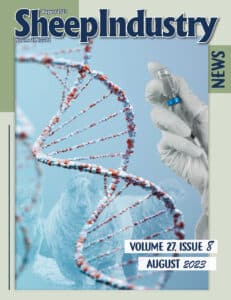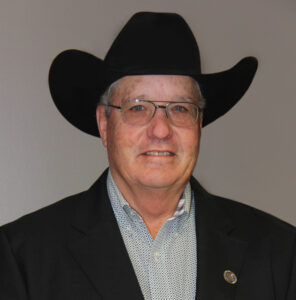RON LEWIS
University of Nebraska-Lincoln
The GEMS in Sheep GEMS means Genetics, Environment, Management and Socioeconomics. The interplay amongst those elements of a production system is the underpinning for this project. Our specific focus is to enhance the sustainability of these systems by genetically improving the robustness and climatic resilience of our sheep flocks.
Why so? Our industry consists of a variety of breeds raised across a range of geographies that not only differ in their climatic conditions, but in their management practices. Breeding robust animals that perform well under these conditions is thereby key. The challenge is that nearly half – 44 percent – of U.S. ewes are culled prematurely for reasons other than age.
Approximately 7 percent of the total American lamb crop dies each year from non-predator related causes. Clinically healthy ewes yet with high somatic cell counts in their milk cause economic losses of $19 to $32 per ewe. More than 20 percent of mature ewes in most commercial flocks have been diagnosed with high somatic cell counts, emphasizing its consequences on ewe productivity.
One way to reduce the impact of these challenges is to breed for greater sustainability. Currently, though, traits that define robustness and climatic resilience are largely absent in domestic genetic evaluations. By working with sheep producers engaged in the National Sheep Improvement Program and U.S. Department of Agriculture Agricultural Research Service facilities with sheep programs, through Sheep GEMS we intend to address this limitation.
By evaluating traits indicative of robustness and climatic resilience – namely lamb survival, ewe longevity, udder health and gastrointestinal parasite resistance – in both industry and research flocks, we plan to develop tools American sheep producers can use to incorporate sustainability into their breeding goals. This includes using genomic information to estimate breeding values more accurately for these new traits, as well as those already included in NSIP.
WHERE ARE WE AT?
Sheep GEMS is in its early days. It began about a year and half ago. To fully evaluate ewe performance across a production season, we need her records collected around breeding, lambing and weaning. With many flocks breeding in the fall, we are just now gathering our first full season of production data.
Industry engagement has been good. Performance records on 17 Katahdin, eight Polypay, seven Rambouillet, and 11 Suffolk flocks have been received so far. We anticipate a few more NSIP flock owners in these breeds submitting their data shortly. In addition, flock records on these same four breeds are being generated at three collaborating USDA/ARS facilities: the Dale Bumpers Small Farms Research Center, the U.S. Meat Animal Research Center and the U.S. Sheep Experiment Station.
We have also collected substantial genomic – molecular – information. Genotypes on more than 12,000 animals are already available, most substantially in Katahdin (10,231), Rambouillet (929), and Polypay (854) sheep. More than half of those genotypes were collected as part of Sheep GEMS.
Most exciting is that during the next couple of years – as we complete our data collection – we will generate a large, unique dataset to thoroughly evaluate robustness, climatic resilience and other key novel traits in our American sheep flocks.
WHAT ARE SOME EARLY OUTCOMES?
Although using molecular information in genetic evaluation has become routine in many livestock species, its uptake is more limited in sheep. In part, that is because of the higher cost of genotyping relative to the value of an individual animal. One way to save on costs is to use a single genotyping platform to generate more molecular-based information.
In Sheep GEMS, the genotyping platform used is a medium-density array with about 50,000 genetic markers. With the genomic information collected with this platform, we can achieve several aims. We can more accurately estimate breeding values – called genomic prediction. We can verify parentage.
We can also determine genetic conditions. Using this 50K array, we have developed and validated a reliable way to determine animals’ status for five genetic conditions: ovine progressive pneumonia susceptibility, scrapie susceptibility, double muscling, callipyge, and booroola FecB. We have already released those results to participating breeders. The extra cost associated with obtaining these specific genetic conditions as independent tests exceeds the cost of the 50K array by itself.
GENETIC CONDITIONS
Genetic condition status can be useful in selection (culling) and mating decisions, and in marketing programs. However, there is no one-size-fits-all approach. In part, it depends on the economic importance of the genetic condition to a sheep enterprise. It also depends on knowing the frequency of various genotypes in a breed and flock, and then using that information judiciously in selection and mating decisions. Culling all animals with less favorable genotypes is seldom the best strategy. From our results (Figure 1), there are clear differences among breeds in OPP and PRNP susceptibilities. That information is useful for designing breeding objectives tailored to the needs and priorities of individual breeds and flocks.
GENOMIC PREDICTION
Improvements in the accuracy of estimating breeding values when incorporating genomic information depend in part on the number of animals with both performance and genotype data within a breed. Those individuals form a breed’s reference population. The reference population needs to capture the full genetic diversity of a breed, which is being accounted for in the design of the genotyping strategy underway in Sheep GEMS.
Breeds differ in their genetic diversity due to factors such as past selection, population size, breeding policies and geographic distributions. Due to these factors, genetic variation is often lost through time. This loss in diversity translates into the number of individuals effectively participating in producing the next generation, or the effective population size (Ne).
The Ne is often substantially smaller than the actual number of individuals in a population or breed. By estimating the Ne of a breed – our proxy for the extent of its genetic diversity – we can approximate the size of the reference population needed to achieve different levels of accuracy from genomic prediction. Estimating the Ne and other genetic diversity measures also helps us to establish a baseline to monitor genetic diversity as we move forward.
Using more than 92,000 pedigree records available through NSIP on Katahdin sheep, we estimated its Ne using a variety of methods. Our minimum estimate was 49. Our average estimate was 75. Using those values, we approximated the accuracy of our breeding value estimates for traits of low (0.1), moderate (0.3) and high (0.5) heritability (Figure 2). With a smaller Ne, a higher heritability, and a larger reference population, accuracies were higher. In Katahdins, with more than 10,000 animals already genotyped, we are already achieving fairly accurate genomic predictions.
There are some key take home messages from this research. First, genetic diversity – and thereby Ne – differs among breeds. Among the aims of Sheep GEMS is to estimate Ne in all the breeds involved based on more accurate genomic methods.
Second, even once the size of a reference population becomes large enough to generate accurate breeding value estimates, genotyping and phenotyping must continue. The reference population must continue to be replenished with animals currently in use in a breed for the benefits of genomic prediction to continue being fulfilled.
GENOTYPE BY ENVIRONMENT INTERACTION
Resistance to internal parasitism is among the robustness and climatic resilience traits being considered in Sheep GEMS. Evaluating this trait has challenges. With sheep being raised in various climates and management systems across the United States, the extent of challenge to gastrointestinal parasites varies appreciably. There is also the potential for a genotype by environment interaction (G x E), where individual animals, or sire families, respond differently to the parasite challenge depending on the climate and management practices in which they are raised.
Working with NSIP Katahdin producers spread across the United States, we conducted a survey to gather information about their management practices. The survey results were combined with climate data from the National Weather Service to form nine eco-management groups or clusters to describe production environments more holistically.
Using body weights, fecal egg counts and FAMACHA scores on 3,527 Katahdin lambs collected at around 90 days of age, we estimated heritabilities both across and within the eco-management clusters. We also tested for G x E. Across the eco-management clusters, heritabilities of BW, FEC and FAMACHA were 0.36, 0.31 and 0.26, respectively. However, within clusters, phenotypic variances and heritabilities differed appreciably.
Heritabilities ranged from 0.30 to 0.37 for BW, from 0.18 to 0.50 for FEC and 0.07 to 0.40 for FAMACHA. Furthermore, we detected substantial G x E in all three traits. The G x E explained 20 percent, 13 percent and 17 percent of the phenotypic variation in BW, FEC and FAMACHA, respectively.
Although accounting for G x E introduces operational challenges in the design and implementation of breeding programs, doing so would improve the efficacy of selection programs to improve parasite resistance.
Returning to the idea that there is no one-size-fits-all solution for everyone, for parasite resistance and other traits with a G x E, we envision providing a tool whereby breeders can obtain EBVs tailored to their climate and management system.
Sheep GEMS is in its early days. Still, our preliminary outcomes are promising. They set the foundation for providing the American sheep industry with methods to improve genetically the robustness and climatic resilience of our flocks. Our success depends on the ongoing support of sheep producers. We look forward to continuing our journey into Sheep GEMS with you.
SCIENTIFIC TEAM
The Sheep GEMS scientific team is Ron Lewis (Project Director), Luiz Brito (Project Co-Director), Brad Freking, Joan Burke, Tom Murphy, Bret Taylor, Carrie Wilson, Sara Nilson, Brian Arisman, Artur Oliveira Rocha and Hilal Yazar Gunes.
ACKNOWLEDGEMENTS
We thank the many American sheep associations and breed organizations, NSIP and sheep producers, for their contributions to this research. This work is supported by the Organic Agriculture Research and Extension Initiative (grant no. 2016-51300-25723/project accession no. 1010329), and by the Agriculture and Food Research Initiative Competitive Grant (grant no. 2022-67015-36073/project accession no. 1027785), from the USDA National Institute of Food and Agriculture. Any opinions, findings, conclusions, or recommendations expressed in this publication are those of the author(s) and do not necessarily reflect the view of the U.S. Department of Agriculture.



